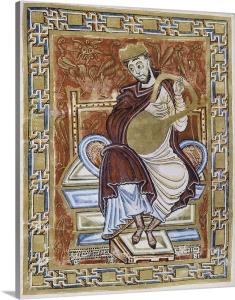I’m visiting with an old friend who is in nursing care, and actually has just entered a hospice program. As he has trouble speaking we’ve settled into a pattern of my reading the psalms to him.
This has given me a project to have a bit better sense of his ancient prayer book of both the Jewish and Christian traditions. What follows are some notes I’ve gathered about the background of the psalms. It’s just an outline. But it occurred to me others might be interested in the background of these ancient hymns, as well.
And, so…
The Psalms are a wildly diverse selection of religious poetry.
We have two sources for the Psalms.
There are 150 psalms in the Masoretic Text version. This is the authoritative Rabbinical Jewish version of the Bible, set in its modern form between the seventh and tenth centuries of our common era. The oldest known complete text, the Leningrad Codex, dates from the early 11th century. Most modern biblical scholarship draws upon the Masoretic Texts as the primary source.
And there are 151 psalms in the Septuagint, the Greek version of the Hebrew Bible. It was created in a process that probably began in the third century before the common era and was completed by 132 BCE. Additional texts appear in variant Septuagint documents dating from possibly as late as 50 CE. Rabbinic Judaism rejected the Septuagint version from the second century of our common era. The early Christian church relied on the Septuagint in the development of its canon and remains the touchstone for the Orthodox churches.
The Psalms themselves are ancient. They were compiled in the Second Temple period, between 516 BCE and 70 CE. And they are sometimes referred to as the hymn book of the Second Temple. They are gathered as the first volume of the third part of the Hebrew Bible, the Ketubim, the “Writings.” The Psalms are the longest book of the Bible, and consist entirely of religious poetry, although the “religion” of some of them is hard to see. Perhaps they all originally meant to be accompanied by music and many offer some guidance to the appropriate instrument to be played as they were recited or sung.
The collection of the Psalms is divided into five books. Contemporary scholarship suggests the first three books, Psalms 1-89 are the oldest strata of the collection. The balance of the psalms don’t appear to have been settled as part of the canon until the turn into the common era.
There are clusters of psalms with related significance. But the only overarching arc to the collection is a general movement from lament to praise. Some psalms are obviously meant for corporate worship, while many seem very intimate and personal. In addition to lament and praise, some are didactic. Individual psalms are sometimes attributed, nearly half to the semi-legendary king David.
The Psalms provide the backbone of liturgical prayer in both the Jewish and Christian traditions. The Quran cites the “Zabur” revealed to King David, which Islamic scholars believe were the Psalms. And there appear to be echoes of the psalms in several passages of the Quran.
The Psalms were the first of biblical texts to be published by Gutenberg on his new movable type printing press. And the most widely printed part of the Bible in vernacular languages during the sixteenth and seventeenth centuries.
The major difference in Jewish and Christian reading of the psalms is how the Christian community interprets many of them through the lens of Christology, seeing Jesus anticipated and sometimes explained. The Christian canon was established starting about the year 200, but not settled among the majority of Christian communities until the Fifth century. How to engage the texts, including the Psalms was divided into two principal schools. The Antiochian school favored a more literal reading, while the Alexandrian school used analogy in quest of deeper and sometimes more mystical readings.
The fourth century scholar bishop Athanasius of Alexandria described the psalms as a “mirror” of the heart. The Oxford Handbook of the Psalms quotes him describing the psalms as revealing “in all their great variety the movement of the human soul.” The Handbook notes that from antiquity Jewish interpretation “mines both the plain sense and the hidden meanings of the text, even enlisting numerology…” Drawing upon the fact that Hebrew letters all have numeric values, and one can seek meaning though a juxtaposition of words with the same numbers.
Since the European Enlightenment scholarly engagement with the texts has been critical and contextual, often informed by what seemed to be the spirit of various psalms related to the time and place of their composition. With the advent of form criticism various types or genres of psalms have been identified. These include hymns of praise, individual complaints, communal complaints, royal psalms celebrating God’s rule, individual thanksgiving, and communal thanksgiving.
Details of these lists vary, but there are broadly recognizable families of psalms. In the twentieth century scholars have turned to the book of psalms itself, and have attempted to discern broad arcs within the composition of the whole collection. Some have discerned grand arcs, or abiding metaphors, such as the presence of the living God, God’s faithfulness, or a movement toward and an end in God. My limited survey of the literature suggests a normative agreement as to what that arc might be, has continued to be elusive. Although each of the three I noted feels true.
More to come…













